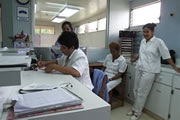
May 22, 2006
Health reforms: Success, failure, or a little of both?

Carmelo Mesa-Lago, consultant to the Economic Commission for Latin America and the Caribbean (ECLAC), tried to answer that question in his new study “Health reforms in Latin America and the Caribbean and their impact on the principles of social security.”
“The goals of the health reforms were clear enough,” Mesa-Lago said. “Keeping the health system solvent in the face of growing operational costs, getting the private sector to take a bigger role in social security and health services by developing competitive insurance and health services markets and giving people more options to choose providers, and establishing more efficient service and more egalitarian coverage, among others.”
But the health systems that emerged from these reforms differ substantially from one country to the next. The state both controls all aspects of health care and provides all health services to a universally covered public in Cuba. But in Colombia, only about half the population is directly covered; with responsibility for the health system divided among four separate authorities that oversee financing, insurance and service provision, with participation by both the public and private sectors.
Regardless of the type of system in place, it’s hard to say even how much of the population was actually covered simply because good coverage statistics are scarce or nonexistent in many countries. While some countries such as Mexico and Panama have statistics showing that their populations enjoy virtually universal coverage, in 13 countries in the region, between 24-43% of the population lacks effective coverage, and even more lack access to care.
“International and regional organizations such as the IDB, PAHO, the International Labor Organization and others need to make a coordinated effort to develop reliable, standardized statistics on coverage as a basis for designing sound policies, estimating costs and defining priorities in this sector,” said Mesa-Lago.
There’s still plenty of room to improve the equality of coverage for marginalized groups, including ethnic minorities, women, the elderly, and people with chronic illnesses, Mesa-Lago indicated.
“Indigenous groups have worse coverage than other segments of the population, for example, while suffering a greater incidence of illnesses,” he said. “Likewise, since the labor force tends to pay women less than men for equal work, women also are have less coverage than men.”
Which services are covered varies significantly across countries, as well. Although 15 of the 20 countries studied offer what Mesa-Lago terms a full or partial “package” of basic services, and two more countries—Haiti and Ecuador—are developing such a package as part of their coverage, three countries (Honduras, Venezuela and El Salvador) still don’t offer such a package.
Defining exactly who is eligible to receive such packages is an unresolved issue, as well. “In some countries, such as Mexico, they are offered in some states, but not in others,” said PAHO health expert María Cecilia Acuña, “while in others, such as Chile, they offer specific coverage benefits and are very inflexible—which is an enormous technical challenge. But even so, 125 million Latin Americans still lack access to health services.”
IDB senior health specialist André Medici agreed, saying “governments have to define their health priorities based on epidemiological evidence in order to set reform goals and, guarantee the delivery of effective health services to the poor and excluded.
In spite of their shortcomings, the reforms have been successful in advancing toward some of the UN’s Millennium Development Goals for the region in the health arena. Substantial progress has been achieved overall in lowering the rates of infant mortality, malnutrition among children under age 5, and mortality from transmissible diseases.
Also available in: Español








